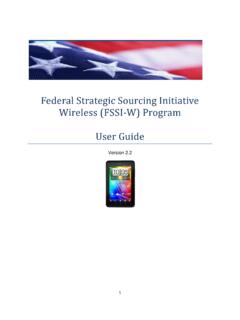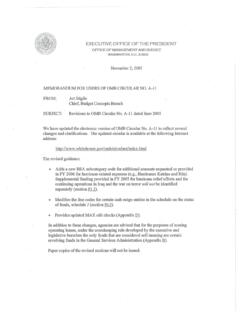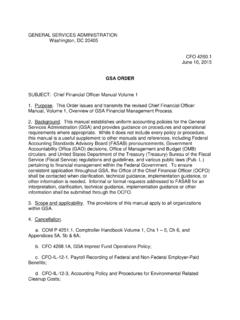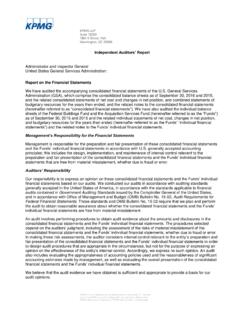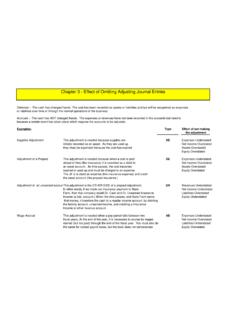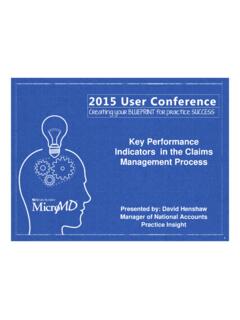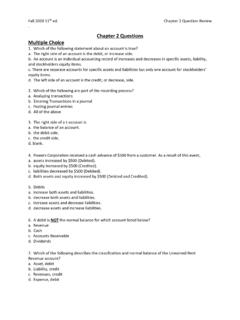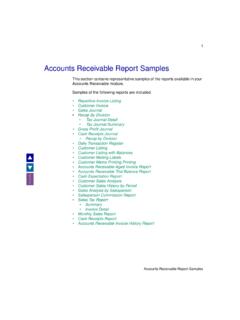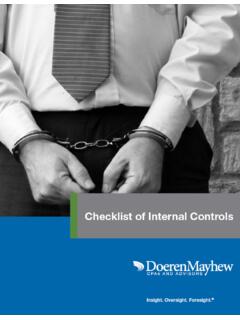Transcription of Accounts Receivable and Debt Collection Manual
1 GENERAL SERVICES ADMINISTRATION CFO P May 2, 2012 Accounts Receivable and debt Collection Manual General Services Administration 1275, First Street, NE Washington, DC 20417 INTRODUCTION This Manual establishes uniform policies for Accounts Receivable functions and provides guidance on procedures and operational requirements for the General Services Administration (GSA). This Manual is a useful supplement to other regulations and guidelines on managing Accounts Receivable , including Federal Accounting Standards Advisory Board (FASAB) pronouncements, Office of Management and Budget (OMB) circulars, Department of Treasury Financial Manual (TFM), and various Public Laws (PL). These policies and procedures apply to all Services and Staff Offices (SSO). GENERAL TABLE OF CONTENTS CHAPTER 1. GUIDELINES, INTERNAL CONTROL, AND CASH MANAGEMENT CHAPTER 2. BILLING AND SERVICING FEDERAL RECEIVABLES CHAPTER 3. BILLING AND SERVICING NON-FEDERAL RECEIVABLES CHAPTER 4.
2 debt Collection CHAPTER 5. REVIEW AND CERTIFICATION OF UNFILLED CUSTOMER ORDER (UFCO) APPENDIX A. ACRONYMS CHAPTER 1. GUIDELINES, INTERNAL CONTROL AND CASH MANAGEMENT Paragraph Paragraph Titles Numbers PART 1. INTRODUCTION Statutes, regulations, and guidelines governing Accounts Receivable operations ..4 PART 2. GENERAL GUIDELINES Recording receivables ..5 Determination of Federal and non-Federal Collections and Business Partner Network Number (BPN)..10 PART 3. INTERNAL CONTROL AND FRAUD PREVENTION AND DETECTION Internal control Internal operation What to do if you suspect fraud ..14 Government Accountability Office (GAO) Standards .. 15 Separationof Systemedits ..17 Rotating office responsibilities ..18 PART 4. CASH MANAGEMENT Scopeand CHAPTER 1. GUIDELINES, INTERNAL CONTROL, AND CASH MANAGEMENT PART 1. INTRODUCTION 1. Purpose. This chapter establishes guidelines and internal control policies and procedures for managing cash and Accounts receivables.
3 The Department of the Treasury (Treasury) Financial Management Service (FMS) requires Federal Program Agencies (FPA) to monitor cash and implement effective internal control policies and procedures to prevent fraud, waste and abuse. 2. Applicability. This information provides policy guidance to those who are performing billing, Accounts Receivable , and Collection functions. 3. Responsibilities. The Accounts Receivable function includes the following responsibilities: customers for goods and services. and adjusting income accruals. the Accounts Receivable subsidiary records. and recording deposits and collections received. and collecting receivables. and collecting non-Federal claims correspondence and answering inquiries regarding bills rendered, Accounts Receivable , and Collection items. and collecting delinquencies. 4. Statutes, regulations, and guidance governing Accounts Receivable operations. debt Collection Improvement Act of 1996 (DCIA), 31 3701 et seq expands the government s right to use Collection tools such as private Collection agencies and offset of government payments of Liability for Accountable Officials and Agents, 31 3527 and 3528, provides standards for Federal agencies in providing relief to accountable officials.
4 In addition, 31 3529 allows disbursing and certifying officials and heads of agencies to request advance opinions concerning the disposition of funds from the Comptroller General. Financial Officers Act of 1990 (CFO Act) 31 9105 et seq., provides guidance on effective financial management practices for the Federal government s financial management, accounting, and internal control systems. Dispute Resolution Act of 1986 (ADRA), 5 Section 584 8, raised the authority of agencies to compromise, suspend, and terminate collections up to $100,000 and gives the Attorney General authority to increase this threshold administratively. Credit Reform Act of 1990, 2 661, a through f, requires agencies to estimate a credit program s subsidy cost for direct and guaranteed loans for inclusion in budget outlays. debt Collection Procedures Act of 1990 (FDCPA), 28 3001 et seq., established a uniform process through the court system for collecting debts owed the Federal government and provides for uniform procedures for enforcing judgments to collect Federal debt .
5 Claims Collection Standards (FCCS), 31 Code of Federal Regulations (CFR) Parts 900-904, provide general rules on debt Collection for Federal agencies. Financial Manual (TFM), Volume 1, contains procedures related to Accounts Receivable policies for collections, deposits, credit management, debt Collection , and central accounting and reporting. Office of the Chief Financial Officer Handbook (CFO Handbook), COM P , prescribes GSA accounting policy and procedures. Financial Officer (CFO) Delegations of Authority, CFO , outlines delegations of authority from the CFO to Heads of Services and Staff Offices (HSSO) and Regional Commissioners (RC). Acquisition Regulation (FAR), 48 CFR. , Compromising Debts, provides policy guidance on the authority to compromise debts. I. GAO, Principles of Federal Appropriation Law, provides guidance on the availability or unavailability of receipts for agency use. Circular A-123, Management s Responsibility for Internal Control, provides guidance to Federal managers on efforts to improve the accountability and effectiveness of Federal programs.
6 Circular A-129, Polices for Federal Credit Programs and Non-Tax Receivables, prescribes policies and procedures for justifying, designing, and managing Federal credit programs and for collecting non-tax receivables. PART 2. GENERAL GUIDELINES 5. Recording receivables. Record Accounts Receivable when services are performed, or supplies or properties are sold. This includes items paid and collected through the Treasury lntra-governmental Payment and Collection (IPAC) system, or other billing method outlined in the inter-agency agreement. Other collections are recorded when received through automated and non-automated lockboxes or other means. 6. Billings. may send detailed listings and supporting documentation containing necessary information to allow customers to identify their requisition, purchase order or other ordering document, or may place the information on an internet website for review by the customer. The billing must also identify any advance payments that were received.
7 Shall be prepared and issued promptly after notification that goods have been shipped, released, or services have been performed. 7. Determination of Federal and non-Federal customers. listed in the Treasury Federal account Symbols and Titles (FAST) book shall be classified as Federal. All other customers will be classified as non-Federal. Contractors that are sponsored by Federal agencies under the provisions of FAR and retain their non-Federal status in all cases. official system of record for GSA Agency Bureau (AB) codes is Pegasys. Although AB codes may be listed in OCFO handbooks or other manuals, the SSO must refer to Pegasys for the most current codes available. The Financial Reporting Division (BCC) will be responsible for establishing or changing AB codes. The SSO must provide documentation upon request to BCC to support AB code setup for a sponsored contractor. 8. Collections and deposits. Financial and Payroll Services Division (BCE) and the Financial Services Division (BCF) must take aggressive action to collect receivables owed on a timely basis, using effective follow-up procedures.
8 Procedures must ensure prompt transfer of deposits to the General Fund of the Treasury in accordance with regulations. 9. Accruals. Record all income earned during the accounting period before closing the Accounts . Record income directly from billing documents when appropriate. Goods and services provided and not billed due to timing and/or lack of documents are recorded as revenue and receivables during the month. Additionally, revenue from commodity orders shall be recognized on delivery. At the end of each month, interest earned but not received must be accrued through the last day of the month and recorded before the month-end closing. Bills for delinquent interest bearing Accounts must include interest earned through the date of the billing. Accrue interest on receivables that have been referred to the Department of Justice (DOJ). Accrue interest, penalty, and administrative costs on non-Federal claims when they are referred to the Treasury debt Management Service (DMS) for cross-servicing Collection .
9 10. BPN Number. The OCFO, Office of Financial Management Systems (BD), is responsible for establishing or changing all BPN numbers within GSA in the Federal Agency Registration (FedReg) system. BD is also responsible for periodic recertification of BPN information in the Federal registry database. To provide for consistency across GSA, SSOs are not authorized to directly register BPN numbers. will provide BD with a hierarchy code along with the entity name and address to establish the BPN number. SSOs shall ensure that every Agency Location Code (ALC) submitted by Federal customers has a valid BPN number. BD will contact the SSO when the account has been established or changed. BPN number will be registered with the Employer Identification Number (EIN), Department Code, ALC and the Disbursing Office Symbol. PART 3. INTERNAL CONTROL AND FRAUD PREVENTION AND DETECTION 11. Introduction. BCE and BCF have the primary responsibility for implementing a system of checks and balances that aid in detecting and preventing fraud.
10 Internal controls shall be designed so that it would be extremely difficult to commit a crime with or without collusion. If controls are weak, steps shall be taken to strengthen them with due consideration to the implementation cost and the potential loss from fraud. The following guidance for preventing or detecting fraud is as follows: a. Cash. (1)Receipts must be recorded and cash deposited promptly. (2)Cash and checks over $5,000 should be deposited within one business day. b. Receivables. (1)Record receivables promptly. (2)Determine and report the source and age of receivables. (3)Make continual, timely attempts to collect receivables due. (4)Identify uncollectible receivables. (5)Validate write-offs and settlement or forgiveness of debt . (6)Collect, control, and report repayments under applicable laws and regulations. (7)Record, file, and secure title to property used as collateral. control obiective. Internal controls are the mechanisms an organization uses to achieve its mission, and at the same time, attain certain management or control objectives such as operational efficiency and effectiveness.
